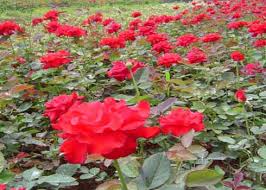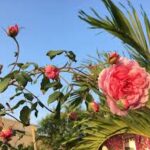
The intricate relationship between flora and fauna in natural ecosystems often yields fascinating insights into the coexistence and mutual dependencies among various species. In this exploration, we delve into the captivating world of Rosa cymosa, a species of wild rose, and its interactions with the diverse wildlife inhabiting forested landscapes. From providing food and shelter to facilitating pollination and seed dispersal, Rosa cymosa plays a crucial role in supporting the biodiversity and ecological balance of forest ecosystems.
#### Introduction to Rosa cymosa
**Botanical Overview**
Rosa cymosa, commonly known as the Cymosa rose or the Seven Sisters rose, is a species of wild rose native to temperate regions of Asia, including China, Japan, and Korea. This deciduous shrub belongs to the Rosaceae family and is characterized by its clusters of fragrant pink flowers, serrated green leaves, and bright red hips. Rosa cymosa typically thrives in diverse habitats, ranging from forest margins and open woodlands to rocky slopes and riverbanks, where it contributes to the structural diversity and visual appeal of natural landscapes.
**Ecological Significance**
Beyond its aesthetic appeal, Rosa cymosa plays a vital ecological role in forest ecosystems by providing habitat, food, and other resources for a wide range of wildlife species. As a native plant species, Rosa cymosa has coevolved with local fauna over millennia, developing specialized adaptations that facilitate interactions with various animals, including mammals, birds, insects, and other wildlife. These interactions form intricate ecological networks that contribute to the resilience and functioning of forest ecosystems, highlighting the importance of preserving and conserving native plant species like Rosa cymosa.
#### Wildlife Interactions
**Food Source for Wildlife**
One of the primary interactions between Rosa cymosa and wildlife involves its role as a food source for numerous animal species. The nutritious hips, or fruit, produced by Rosa cymosa are rich in vitamins, minerals, and antioxidants, making them highly sought after by wildlife, particularly during the autumn and winter months when food resources may be scarce. Mammals such as deer, squirrels, and rabbits, as well as birds including thrushes, waxwings, and grouse, are known to feed on Rosa cymosa hips, benefiting from their energy-rich nutrients and contributing to seed dispersal through their activities.
**Shelter and Nesting Sites**
In addition to providing food, Rosa cymosa also serves as a valuable source of shelter and nesting sites for a variety of wildlife species. The dense foliage and thorny thickets of Rosa cymosa shrubs offer protection from predators and harsh weather conditions, providing refuge for small mammals, birds, and insects. Many bird species, such as sparrows, finches, and warblers, build their nests among the branches of Rosa cymosa shrubs, utilizing the structural support and camouflage provided by the dense vegetation.
**Pollinator Attraction**
Rosa cymosa’s vibrant flowers attract a diverse array of pollinators, including bees, butterflies, moths, and beetles, which play a crucial role in the plant’s reproductive success and genetic diversity. These pollinators visit Rosa cymosa flowers in search of nectar and pollen, inadvertently transferring pollen between flowers as they forage. By facilitating pollination, Rosa cymosa contributes to the production of viable seeds and the continuation of its life cycle, while also supporting the broader ecosystem by sustaining pollinator populations and promoting floral diversity.
#### Conservation Considerations
**Habitat Preservation**
Conserving and protecting the natural habitats where Rosa cymosa grows is essential for maintaining its ecological interactions with wildlife and preserving biodiversity. Forest conservation efforts, including habitat restoration, reforestation, and sustainable land management practices, can help safeguard the populations of Rosa cymosa and other native plant species, ensuring their continued availability as food and habitat resources for wildlife. By protecting the natural habitats of Rosa cymosa, we can also safeguard the ecological services it provides, including soil stabilization, erosion control, and carbon sequestration.
**Invasive Species Management**
Invasive species pose a significant threat to native plant communities and the wildlife that depend on them, including Rosa cymosa. Invasive plants such as multiflora rose (Rosa multiflora), a close relative of Rosa cymosa, can outcompete native species, alter ecosystem dynamics, and disrupt ecological interactions. Implementing invasive species management strategies, such as targeted removal, herbicidal control, and biological control methods, can help mitigate the impacts of invasive plants and protect the integrity of native plant communities like those dominated by Rosa cymosa.
#### Conclusion
Rosa cymosa’s interactions with wildlife underscore the interconnectedness of plant and animal species in forest ecosystems, highlighting the importance of conserving native plant diversity for maintaining ecological balance and supporting biodiversity. From providing food and shelter to facilitating pollination and seed dispersal, Rosa cymosa plays a multifaceted role in sustaining the web of life in natural landscapes. By understanding and appreciating the ecological significance of Rosa cymosa and its interactions with wildlife, we can foster greater awareness and stewardship of forest ecosystems, ensuring their continued health and resilience for generations to come. Stay tuned for the next part of our exploration, where we will delve deeper into the fascinating world of Rosa cymosa and its ecological relationships with other plant species and environmental factors.
### Exploring Rosa cymosa’s Relationship with Forest Wildlife (Part 2)
In the previous section, we delved into the intricate interactions between Rosa cymosa, a species of wild rose, and the diverse wildlife found in forest ecosystems. From providing food and shelter to facilitating pollination and seed dispersal, Rosa cymosa plays a crucial role in supporting the biodiversity and ecological balance of forested landscapes. In this continuation, we’ll further explore the dynamic relationships between Rosa cymosa and forest-dwelling animals, highlighting the importance of conserving these interactions for ecosystem health and resilience.
#### Seed Dispersal Mechanisms
**Avian Dispersers**
Birds play a vital role in dispersing Rosa cymosa seeds across the landscape through their feeding behaviors and movement patterns. Many bird species consume the nutritious hips of Rosa cymosa, digesting the fleshy pulp and excreting the seeds in different locations as they travel. This process, known as endozoochory, helps disperse Rosa cymosa seeds over long distances, contributing to the plant’s colonization of new habitats and the maintenance of genetic diversity within populations. Birds such as robins, cedar waxwings, and thrushes are among the primary seed dispersers of Rosa cymosa in forested areas, where they play a crucial role in shaping plant distribution patterns and ecosystem dynamics.
**Mammalian Dispersers**
In addition to birds, mammals also contribute to the dispersal of Rosa cymosa seeds through their foraging activities and movements within forest habitats. Small mammals such as mice, chipmunks, and squirrels may consume Rosa cymosa hips and scatter seeds as they search for food or cache them for later consumption. Larger mammals such as deer and bears may also inadvertently disperse Rosa cymosa seeds through their browsing behavior and movement across the landscape. By harnessing the mobility and foraging behaviors of wildlife, Rosa cymosa maximizes its chances of seed dispersal and colonization, ensuring the persistence and expansion of its populations within forest ecosystems.
#### Mutualistic Relationships
**Pollinator Partnerships**
Rosa cymosa relies on a diverse array of pollinators to facilitate successful reproduction and seed production. In return for nectar and pollen rewards, pollinators such as bees, butterflies, and beetles inadvertently transfer pollen between Rosa cymosa flowers, promoting fertilization and seed development. These mutualistic relationships benefit both the plant and pollinator species involved, ensuring the continued survival and propagation of Rosa cymosa populations while supporting the reproductive success of pollinator communities. By attracting and rewarding pollinators, Rosa cymosa contributes to the maintenance of floral diversity and ecosystem stability within forested landscapes.
**Nesting and Roosting Sites**
The dense foliage and thorny thickets of Rosa cymosa shrubs provide valuable nesting and roosting sites for a variety of forest-dwelling animals, including birds, small mammals, and insects. Birds such as songbirds, sparrows, and warblers may build their nests among the branches of Rosa cymosa shrubs, utilizing the structural support and protective cover offered by the dense vegetation. Small mammals such as rabbits and rodents may also seek refuge within Rosa cymosa thickets, utilizing the sheltered microhabitats for nesting, resting, and raising their young. By providing habitat and shelter, Rosa cymosa enhances the ecological diversity and resilience of forest ecosystems, supporting the survival and reproduction of diverse wildlife species.
#### Conservation Implications
**Habitat Connectivity**
Maintaining connectivity between fragmented forest habitats is essential for facilitating the movement and dispersal of wildlife species, including those that interact with Rosa cymosa. Conservation efforts aimed at preserving and restoring forest corridors and green spaces can help mitigate the impacts of habitat fragmentation and support the continued survival of wildlife populations that depend on Rosa cymosa and other native plant species. By enhancing habitat connectivity, we can promote gene flow, genetic diversity, and ecosystem resilience, ensuring the long-term viability of forest ecosystems and the wildlife communities they support.
**Invasive Species Management**
Invasive plants pose a significant threat to native plant communities and the wildlife that depend on them, including Rosa cymosa. Invasive species such as Japanese knotweed (Fallopia japonica) and Himalayan blackberry (Rubus armeniacus) can outcompete native vegetation, disrupt ecological interactions, and alter ecosystem dynamics, leading to habitat degradation and loss of biodiversity. Implementing invasive species management strategies, such as targeted removal, herbicidal control, and biological control methods, is essential for controlling the spread of invasive plants and protecting the integrity of native plant communities like those dominated by Rosa cymosa.
#### Conclusion
Rosa cymosa’s interactions with forest wildlife illustrate the complex web of ecological relationships that shape forest ecosystems and support biodiversity. From seed dispersal and pollination to habitat provision and mutualistic partnerships, Rosa cymosa plays a multifaceted role in sustaining the ecological balance and resilience of forested landscapes. By understanding and conserving these interactions, we can ensure the continued health and vitality of forest ecosystems, preserving their ecological functions and the diverse array of wildlife species that depend on them. Stay tuned for the next part of our exploration, where we will delve deeper into the fascinating world of Rosa cymosa and its ecological relationships with other organisms and environmental factors.










